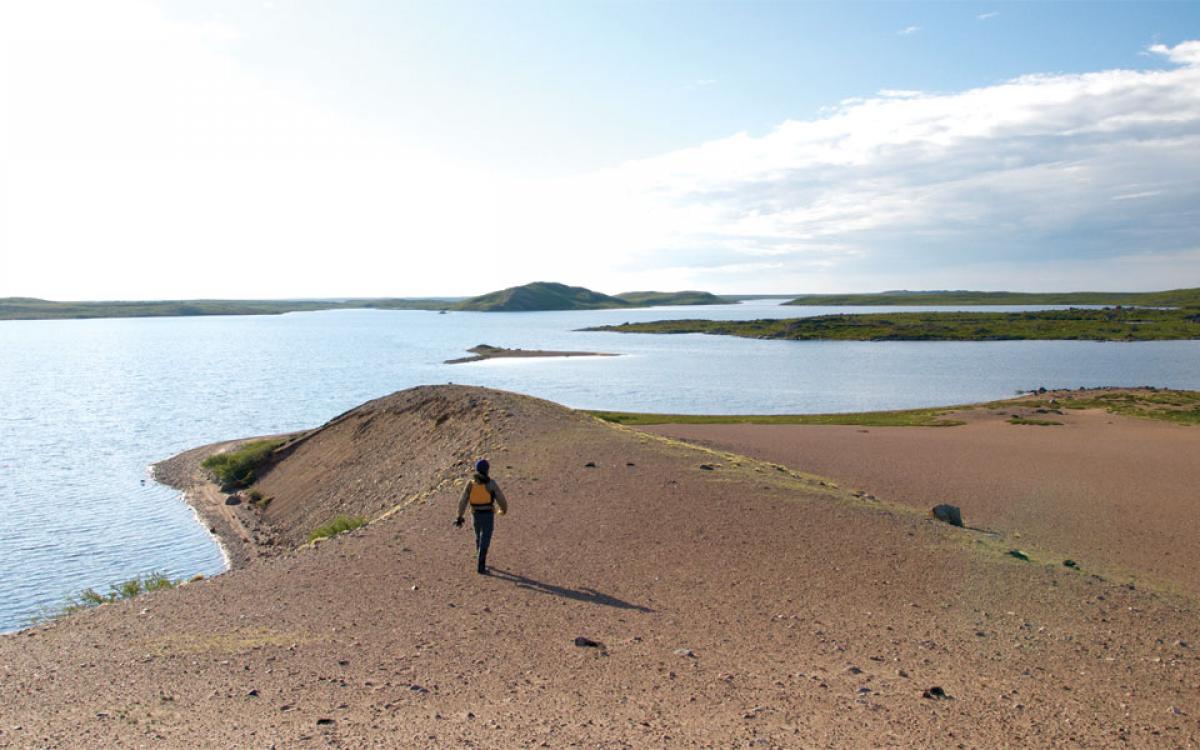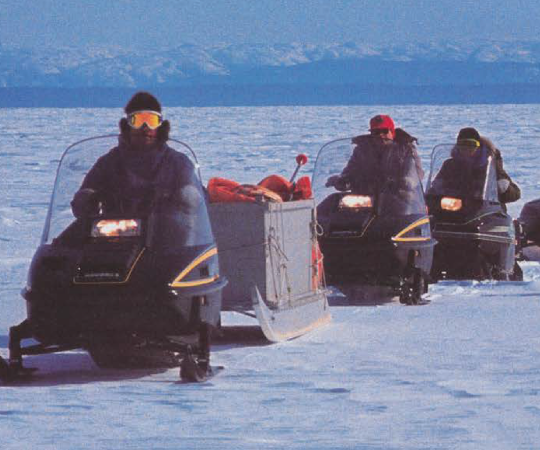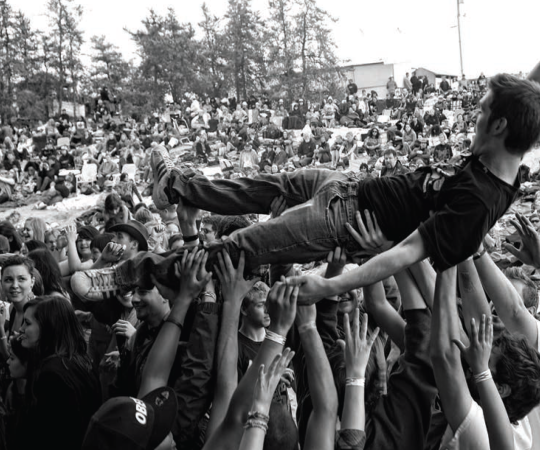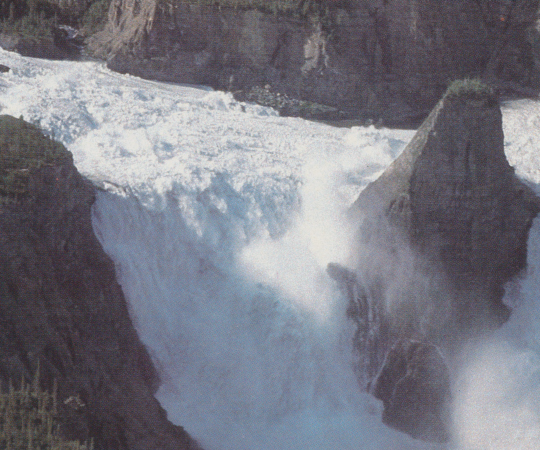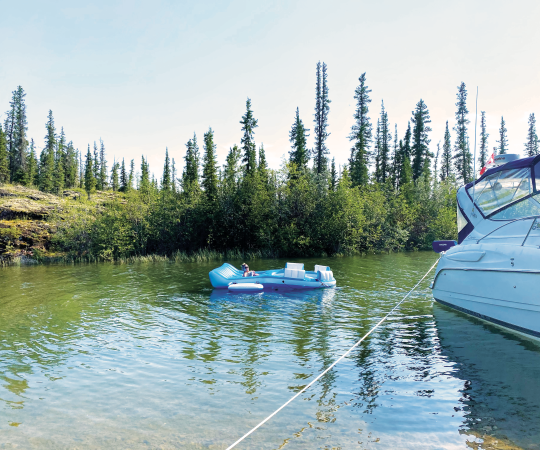The winds came up in the afternoon and for a few hours after our lunch break we battled them. Ready to rest our weary shoulders, we turned into a narrow bay and saw a black mass run along the beach, with a smaller one not far behind. I whispered to John, “A black bear and cub,” but eight more black masses came out of the woods, all of them running across the beach. We positioned the bow of our canoe into a bed of sedge and pulled binoculars out when the black masses began to moo and their barnyard odour reached us.
We had not anticipated encountering our first muskoxen here, on the eastern shores of Great Slave Lake. But here they were, far below their traditional tundra habitat above the treeline, frolicking.
The immensity of Great Slave Lake cannot be comprehended from its shore. At the beginning of the summer, my partner John and I slipped our canoe into the water at Old Town, Yellowknife, put paddles to the water and set off for the lake’s eastern end some 450-kilometres away. The East Arm is slated to become Canada’s newest national park, Thaidene Nene. For 18 days John and I paddled its northern shore on our way to Pike’s Portage, the Hanbury River and then the Thelon Rver. It would be a two-month trip out of the subarctic boreal forest and into the barrenlands.
We expected wind to be a great foe but we had not anticipated it would be such a constant. Low-pressure systems rolled in day after day, churning the lake into a sea of whitecaps. But when the winds did fall, Great Slave’s crystalline waters resembled a tropical ocean. Sometimes fog would linger late into the day, swallowing the Earth and forcing us to rely on compass bearings for bay crossings.
The winds were strongest mid-day, so we would paddle in the early dawn, followed by long, languid lunches on exposed headlands when the winds kicked up. Often we would paddle late into the evening once calm returned, taking advantage of the midnight sun.
On our tenth night, snug inside sleeping bags, John and I were startled awake by a loud snort above our heads outside our tent. There was no mistaking the noise; we have heard it before. John voiced a stern “Hello?” and a branch snapped and everything was silent but our thrumming hearts. John crawled out, bear spray in hand, while I stuffed gear into stuff sacks. We packed up, loaded our canoe and pushed off, spending no time on the illusion that we’d be able to sleep that night at that site. We’d struggled to find the site, though. A massive forest fire had burned much of the land. Eventually we chose a charred island twenty metres from shore. We hoped no bears would think it was worth the swim. Our aborted campsite set the tone for the rest of my day. I spilled my tea, spilled our thermos, dropped my boot in the water then got my socked foot wet retrieving said boot. It would be some time before we slept soundly again.
We hadn’t anticipated that our highlight of travelling the big lake would be its birdlife but every day we had some remarkable encounter. Mergansers, common loons and long-tailed ducks swam alongside our canoe while Pacific loons dove at our approach. Flocks of 50 terns swooped and fished with unbounded energy, fresh off a 20,000-kilometre migration from their wintering grounds in Antarctica. Caspian terns, their larger cousins, aggressively defended their nests. We stumbled upon nesting American wigeons, spotted sandpipers and dark-eyed juncos. As we paddled beneath cliffs, common ravens and peregrine falcons watched us from their nests.

From the east end of Great Slave, Pike’s Portage leads to the Barrens. It is a historic route, comprised of eight portages connecting nine lakes, that was used for centuries by the Dene, Cree and Inuit, then later by European explorers and trappers. These days, it mostly sees recreational paddlers.
We pulled up onto a crescent-shaped beach before the first portage. Caribou antlers were the only litter, wolf and caribou the only tracks before we added our own. We spent our final evening on Great Slave burning books to lighten loads and savouring the last of the chocolate chip cookies before crawling into bed while the sun still hung in the sky.
The first of Pike’s portages is the longest, a knee-busting five kilometres with 600 feet of elevation gain, much of it through a burnt forest—and that’s five kilometres one way. Three trips, 12 hours and 25 kilometres later, we were finally free of it. The temperature was above 30 C for most the day and the bugs were deliriously lively. The land, it seemed, was conspiring against us. After we’d battled the wind for 18 days on Great Slave, it had blown itself breathless, and the one week we would have welcomed a stiff breeze, overcast skies and single digit temperatures, we were blessed with “good weather.” We sweated inside our bug jackets, trudging on a wide and obvious trail that petered into a footpath lined with blooming pink corydalis before disappearing in a marsh. Qiviut, the soft, warm undercoat of muskoxen, clung to branches along the trail.
It has been said about Pike’s that if you can lift it, it can be taken over Pike’s. What it doesn’t convey is the trail is often not a trail at all, certainly not by southern Canadian standards. Many of Pike’s travellers have made this mistake, and the trail is littered with wondrous, abandoned contraptions made for hauling canoes full of gear over well-groomed portage trails.
Our arrival at Harry Lake, the first on the portage route, was underwhelming. The forest was burnt and we found no exposed campsite to catch the breeze and chase away bugs. We pitched our tent reluctantly on the only flat spot around, beside a well-used muskoxen wallow.
The next four days we carried our loads from one lake to another, guided by overgrown paths or rock cairns. Sweat dripped from our hairlines, gathering bug dope, sunscreen, dirt and soot before reaching our eyes, but with our bug jackets zippered shut we could not wipe it away. Along the trail we would pause for a hug or a kiss for encouragement. I would squish a mosquito in John’s beard and he would slap my face, killing a blackfly.
Once we reached Artillery Lake at the end of Pike’s Portage the insects had taken their toll. John looked like an intravenous drug user while I looked I was harbouring a raging venereal disease from all the resulting exposure.
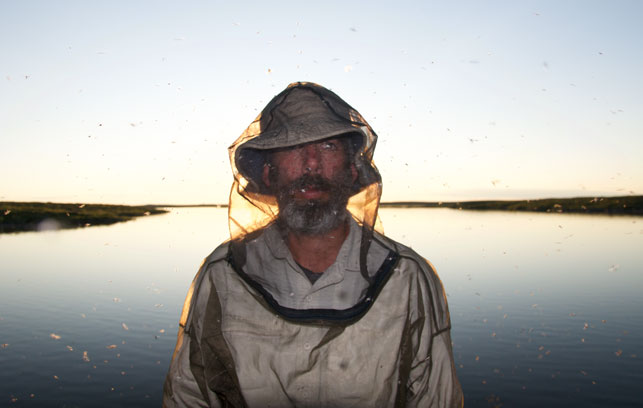
At the end of the portages, we reached Artillery Lake, where the boreal forest disappears. It’s 95 kilometres up the lake to the Lockhart River, and, then we cross Ptarmigan Lake, and portage to the Hanbury River. As we paddled north of the treeline, the vastness of the tundra, its stark beauty, fragility and harshness, revealed itself. There would be no more shade, no more smoky campfires to keep the bugs away; we were exposed now to the many moods of the Barrens.
And to the birds and beasts. A curious yellow-billed loon swam circles around our canoe early one morning; peregrine falcons, nesting on the cliffs of Beaver Lodge Point, accosted us. Near the Lockhart River, we watched a wolverine hop and pounce along the shoreline. Caribou antlers and wolf tracks littered the beaches, and qiviut, drifting in the wind, marked the passage of muskoxen. Despite its name, the Barrens teem with life.
High water levels made travelling the Lockhart River, 20 kilometres upstream, a slog. Many of its rapids were too strong for lining. In one long day we paddled, lined and portaged three rapids to reach Ptarmigan Lake, where winds swept across the land and water to desiccate our skin, wick the moisture from our parched throats and deposit sand in the depressions of our molars. Windbound for several days, we wandered around giant granite boulders plopped arbitrarily on the tundra by long-ago glaciers. Fresh-out-of-the-egg sandpiper chicks ran about us on spindly legs; snowy owls on silent wings swooped overhead, curiosity pulling them from their rocky perches.
From Ptarmigan Lake, three short unmarked portages to two unnamed lakes brought us to Deville Lake, a large lake near the headwaters of the Hanbury River where, finally, we could enjoy currents that flowed with us.

By this point in our trip we could gauge our exhaustion and our hunger by whether we’d bother picking blackflies out of our supper and tea. We could fall asleep on a glacial erratic in minutes, suffocating inside bug jackets. But we’d still wander into the hills, as if in a trance, in search of muskoxen, caribou and birds.
The Hanbury is considered less a river than a series of large lakes connected by rapids and canyons. Armed with vague river descriptions and old topographic maps, each stretch of roaring water required scouting and high water levels meant we had to portage much of it—portages as challenging and lengthy as Pike’s.
The sections we did run tested our whitewater skills. Kamikaze mosquitoes flew into our eyes just as we were lining up at the top of a chute. Angry nesting gulls would take to the skies, screeching and diving at us in the midst of eddy turns. The winds were stronger than the currents and we found ourselves more than once unwillingly running a rapid sideways.
The bipolar nature of the Barrens weather kept us on edge, struggling against daily winds, ferocious bugs, cold temperatures or extreme heat. After a rainstorm the skies would turn a blazing blue but as soon as we finished bathing and washing laundry, cirrus clouds, harbinger of more rain and wind to come, would return. We were left scrambling to find a sheltered nook for our tent, which we would secure with stakes driven deep into the ground, braced for the storm to come. All the hardships were forgotten, however, when muskoxen appeared. The Great Slave muskoxen had been boisterous and playful, but these beasts on the Barrens were rather sedentary. Bulls seemed content grazing alone while females and young in small herds slept close together. The upper Hanbury provided us with numerous opportunities to drift past them and marvel at their prehistoric visage.
Near the end of the Hanbury, we had to portage around several waterfalls and canyons, but the beauty and bounty—ripe blueberres and cloudberries abound—
distracted us. We crept along the edge of the Dickson Canyon to peer down into the chasm and were stunned into silence.
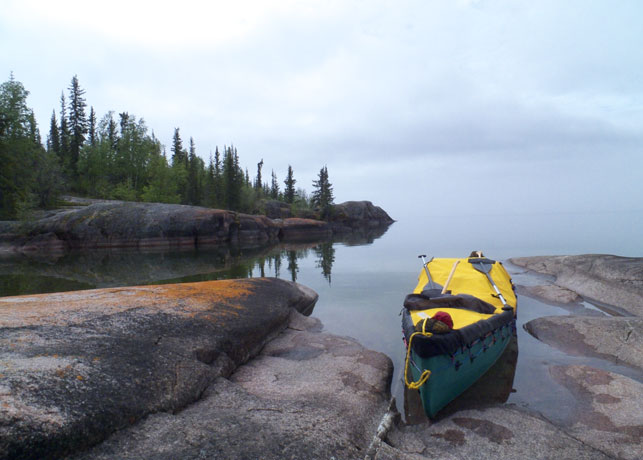
A day later, we swam beneath Helen Falls, the tallest of waterfalls along the Hanbury. A brilliant sun and a miraculous lull in bugs granted us an idyllic afternoon of swimming. Afterward, on the great slabs of limestone, we stretched out to dry, watching a pair of nesting peregrine falcons feed squawking young perched in a cliff nest above the waterfall.
We finally reached the lower Thelon River, where we drifted lazily with the current. The rapids and canyons were behind us and the river provided more shelter from the wind. Our biggest challenges now were finding suitable campsites along the muddy shores and staying dry in frequent rainstorms.
Upon entering the Thelon Game Sanctuary the landscape changed. Though we were 160-kilometres north of the tree line, white spruce trees thrive along this stretch of the Thelon. It’s an oasis.
William Hoare was the sanctuary’s first warden, travelling 269 days from Fort McMurray, Alberta by dogsled in 1928 to build a cabin and establish a warden’s post high above the river in a thick stand of spruce. We spent a rainy afternoon wandering Warden’s Grove, marvelling at the stone slab floors of his cabin.
Several lazy days of paddling later we reached Hornby Point, where, in 1926, English explorer John Hornby and his two companions built a cabin intending to live off the land for a year. The caribou failed to appear that winter and, ill-supplied, all three starved. Their cabin and gravesites remain but are slowly being reclaimed by the woods that failed to provide for them.
As we approached Hornby Point, a grizzly ambled the opposite shoreline, nose to the river stones, leading her into the willows, the tundra beyond and out of view. Wary but confident we pulled up to Hornby Point. As we tied up our canoe, the grizzly reappeared on the opposite shore, this time her nose pointed in our direction. Without hesitation she took to the river, her massive paws cutting the water, the current helping her quickly close the gap between us. No discussion was needed. John and I threw our packs into the canoe and pushed off, paddling hard, bear spray in our laps. We peered back repeatedly, relaxing once we realized our paddle strokes were stronger than hers. The grizzly pulled up to Hornby Point, shook the water from her massive frame and wandered into the forest. Finding Hornby’s cabin and gravesite would have to wait for another trip.
Approaching Beverly Lake and the end of our trip, we spent our afternoons strolling hillsides searching for ancient Inuit tent rings and stone tools. At Lookout Point, with its sweeping views over the river and tundra beyond, it was easy to see why this site was well used by the Inuit. We sat feasting on berries, scanning the land for caribou and reflected on our journey. Our feelings were conflicted about the luxuries Yellowknife would soon offer: fresh fruit, ice cream. Hot showers. After 59 days of wilderness travel we were ready for some decadence, but we also knew that after a day or two of indulging we would immediately wish to return to sit on this riverbank.
Our floatplane retraced our route down the Thelon. What had taken us two months to paddle, portage and line took only three-and-a-half hours to fly. Just like that, the hardships, the simplicity of the outdoor life, the beauty and vulnerability we experienced fell away, leaving us disjointed and startled, standing on the pavement in Yellowknife’s Old Town. Our journey was now a memory. Already, we longed to return.

